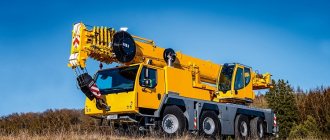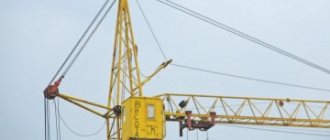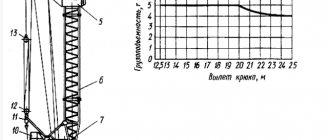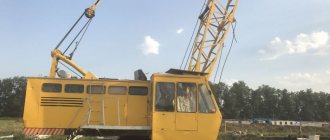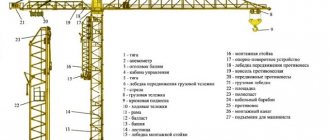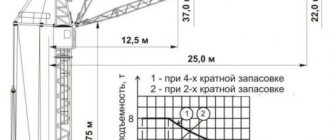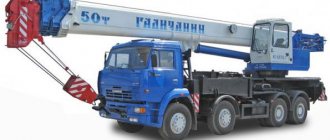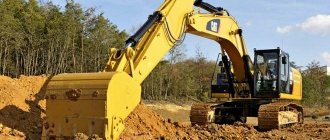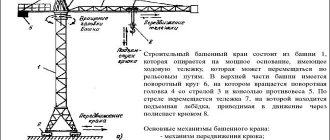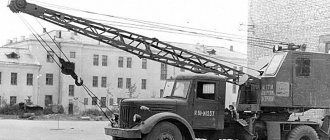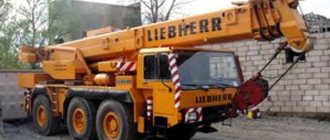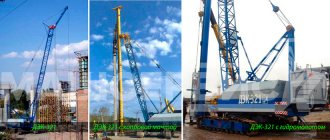A tower crane is a mechanism designed to lift and carry loads over long distances and heights.
Its operation is based on the use of a rotary mechanism and a boom, as well as a tower located at the top. When using a tower crane on a construction site, the main task it performs is servicing warehouses and structures being built.
At the same time, the crane changes the height of the boom, its reach, rotates to the required angle and moves the required distance. It should be noted that the lifting, turning, and moving mechanisms are equipped with limiters - a safety system that can be controlled from the cabin.
Tower crane - types and characteristics
| Allocated according to purpose | |||
| general purpose | high-rise | special | loading |
| If possible, move: | |||
| Stationary (universal and attached) | Mobile (trailered and self-propelled) | Self-elevating (mounted and used on the building) | |
| By type of running gear | |||
| automobile and pneumatic tires | Rail and crawler | walking | automobile type chassis |
When determining the type of tower crane required, we are guided by three main calculations: lifting capacity, hook lifting height, and boom radius. Since the KB series of tower cranes with a rotating cabin is more in demand, we will consider their main types in more detail. Characteristics of other options, for example, with a fixed tower or used for loading...
KB-100
Tower crane KB-100
wide application - it can be used for the construction of buildings for various purposes, while the height of buildings can be from 5 to 9 floors.
It should be noted that the abbreviation KB-100 is usually used to refer to modifications KB-302, KB-301, KB-307, KB-303
. The feasibility of using a particular option is determined by. All of them are high-rise mobile (on a rail) installations with an inclined boom and a rotating tower.
Crane KB-100.1
has the parameters of KB-100 and is used for similar purposes.
Its only difference is in the design. In its manufacture, automatic welding is used to produce the tubular design of the boom, tower and ring-shaped turntable. On the rotating platform you can place winches: L-500
and
L-450
, as well as
P-3
.
Modification KB-100.2 is intended for the construction of 9-story buildings. Based on the KB-100.1
. It should be noted that when installing two KB-100.2 cranes on both sides, it is possible to build a house of up to 12 floors. What difference does this construction machine make? This is a telescopic tower assembled from two main parts. When the tower is retracted, the operator can work with a lifting height of 21 m, and when extended, it is 31 m. In addition, this design makes it easier to transport.
Technical characteristics of KB-100
Below you can see the characteristics of cranes KB-100 OA, KB-100.2, KB-100.3
. All of them are manufactured in two versions: using a lattice or tubular system.
KB-401
Tower crane KB-401
is a development of the
KB-160.2
.
It is equipped with a rotating tower, a rotating boom (8 t - lifting capacity). At maximum reach, the carrying capacity of the KB-401 is, of course, less. It should be noted that the model has 5 trimmed sections. Modifications are KB-401B
and
KB-401A
.
The KB-401HL crane is a variation of the KB-401, used in regions with cold climates - down to -60 degrees. It can be used to lift loads to a height of 47 meters.
Characteristics of KB-401
Below are the main characteristics of the KB-401 crane, as well as its main modifications. Eg. lifting capacity, lifting height and boom radius.
KB-402
Tower crane KB-402
is an improved modification of the KB-160.4, equipped with rail travel and a rotating turret.
The boom reach of this model is 25 meters, and the load capacity reaches 8 tons. Other varieties are: KB-402A, KB-402B
.
Technical characteristics of the crane KB-402
In the table below you can estimate the ratio of the crane's lifting capacity to its boom radius.
KB-503
Crane KB-503
is a modification of
KB-502
and is intended for operation in 1-3 wind regions.
It should be noted that it can also be used under stronger wind loads (4-7 wind regions) with a reduced tower height. There are three versions of KB-503
- depending on the number of inserts:
KB-503.1, KB-503, KB-503.2
.
It should be noted that the KB 503 tower crane operates on direct current, and the converter is located on the rotary platform. Its use is also possible with 4-7 point wind loads, but this requires equipment for a parking area, as well as bracing the tower.
If it is necessary to build large buildings, you can use modifications KB-503B.21 (lifting height 80 m), KBSM-503B - lifting height up to 90 m, and boom radius 50 m.
Characteristics of KB-503
The table shows the characteristics of the KB 503 crane, as well as the characteristics of its modifications.
KB-504
Tower crane KB-504
It has a lifting capacity of 10 tons and has two versions:
KB-504.1
- 35 meters boom,
KB-504.1
- 40 meters boom reach. It should be noted that the KB-504 crane has a height of 40 m. Since its height is significant, it is equipped with a special cargo-passenger elevator. A special feature of the construction machine is that the boom can be installed in an inclined and horizontal position. At the same time, the load moved along the inclined boom moves almost horizontally. The DC generator is mounted on a turntable.
Technical characteristics of the crane KB-504
Below are the characteristics of KB-504, KB-504.1, KB-504.2
(load capacity, boom radius, and lifting height).
KB-602
Crane KB-602
has a load capacity of 25 tons and is assembled from low-alloy pipes. It is assembled using its own elements, as well as using an auxiliary crane. The crane winches are designed in such a way as to transfer the load smoothly and slowly.
Technical characteristics of the crane KB-602
Tower KB-403 is a self-assembling
mobile mechanism
.
The full-slewing crane is electrically controlled and has a rail-mounted girder boom equipped with a load trolley.
Both the basic model and its subsequent modifications (“A”, “B”) were produced at several Russian factories (Nyazepetrovsk, Podolsk, Karacharovsk, Moscow “PO Stroymash”, etc.)
Cranes began to be produced in Russia at the end of the 19th century, but production was sporadic.
After the Great Patriotic War, USSR factories began to produce up to 4,000 tower cranes annually, but they were all of different types, which hampered the development of crane construction.
In
the post-war years the first series BKSM cranes was launched .
The construction was made of brick, so the devices were used mostly for reloading and supplying materials to the top.
In the second half of the 20th century, large-block, frame construction began to rapidly develop in the country, and in 1960 the KB
-
Kran
Bashennyh
. _ The series was designed for 8 models, not counting modifications.
Installation of a KB-602 tower crane with a lifting capacity of 25 tons from enlarged units
EniR
§ E35-33. Installation of a KB-602 tower crane with a lifting capacity of 25 tons from enlarged units
Time standards and prices for 1 tap
| Name and scope of work | Installers of construction machines and mechanisms | Time norms Prices . | № |
| Crane installation | — | 222,9 197-72,4 | 1 |
| Including: | |||
| Installation of the crane running gear on the crane tracks: installation of the support frame on the inventory stand; installation of weather vanes into working position with detachment from the beam and securing them; installation of running trolleys on crane tracks; disconnecting the support and chassis from the transport devices; cable drum installation | 6 sizes - 1 4 » — 1 | 33,5 30-99 | 2 |
| Loading ballast onto the lower frame | 4 size - 1 3 » — 1 | 6,6 4-92 | 3 |
| Installation of the support (two-legged) stand into the working position with lifting, installation of fingers and struts | 6 sizes - 1 4 » — 1 | 5 4-63 | 4 |
| Installation of counterweight plates on a turntable with loading and fastening | 4 size - 1 3 » — 1 | 8,2 6-11 | 5 |
| Connecting the tower base to the turntable with installation of an inventory stand, disconnecting the front and rear axles of the transport device, installing struts on the tower base | 6 sizes - 1 4 » — 1 | 7,8 7-22 | 6 |
| Installation of platforms and stairs on the base of the tower | 4 size - 1 3 » — 1 | 10,5 7-82 | 7 |
| Installation of the upper section of the tower head with docking and fastening | 6 sizes - 1 4 » — 1 | 2,4 2-22 | 8 |
| Installation of platforms, ladders, floodlights, small parts (lightning rod, wind speed sensor, rod to prevent the rope from falling out of the stream, etc.) on the top of the tower. | 4 size - 1 3 » — 1 | 3,7 2-76 | 9 |
| Rewinding a rope with a jib guy with installation of an inventory stand, installing a coil of ropes on the stand, unraveling and straightening the ropes with lifting the free ends of the rope onto the platform | 6 sizes - 1 4 » — 1 | 4,4 4-07 | 10 |
| Installation of the jib guy rope on the head with removal and installation of the casing, blocks and reeving of the jib guy rope | Same | 3,9 3-61 | 11 |
| Refilling the jib pulley with installation, fastening and winding of the rope onto the drum of the cargo winch | « | 6 5-55 | 12 |
| Lifting the base of the tower into a vertical position with a cabin section fixed inside, installing spotlights on the base of the tower, checking before lifting the fasteners and tightening the bolts of the base, installing a coupler on the crane runways, unwinding the rope, reeving the traverse lifting rope, disconnecting the mounting pulley clip, joining the tower struts with two-legged stand, installation of fences after lifting the tower, dismantling the inventory stand | « | 12 11-10 | 13 |
| Installation and removal of inventory support with fastening and disassembly | 4 size - 1 3 » — 1 | 3,9 2-91 | 14 |
| Disconnecting, lowering and securing the mounting pulley cage | 4 size - 1 3 » — 1 | 1,2 0-89,4 | 15 |
| Reattaching the cargo rope to the auxiliary winch and reattaching the pulley | 6 sizes - 1 4 » — 1 | 2,5 2-31 | 16 |
| Building up a tower from individual sections: with attaching sections to an inventory support, installing sections in a vertical position, extending the tower, docking and connecting tower sections, detaching sections from the inventory support and lifting up together with the tower, detaching thimbles from the raised section and attaching to the mounted section ; installation of diagonal beams with subsequent installation of the tower on them | Same | 32 29-60 | 17 |
| Assembling the boom from separate sections with laying the boom parts on crane tracks, joining the boom sections with fingers | « | 4,2 3-89 | 18 |
| Repositioning the rope into the working position with insertion of the cargo rope through the tensioning device and guide booms, unwinding the rope from the reels and rewinding the rope to the cargo winch | « | 9,7 8-97 | 19 |
| Attaching the boom to the tower by lifting the boom to the head lugs and securing the boom to the tower lugs with fingers | « | 3,3 3-05 | 20 |
| Reeving the boom guy rope into the working position with the attachment of thimbles with the installation of an anti-tipping device, reeving the boom rope, reeving the cargo suspension with attaching the carriage and suspension to the boom, lifting the boom to the working position | 6 sizes - 1 4 » — 1 | 14 12-95 | 21 |
| Installation of the platform, entrance stairs to the cable drum counterweight tower, transition platform on the running frame and cable drum counterweight guard | 4 size - 1 3 » — 1 | 11 8-20 | 22 |
| Partial installation of electrical equipment with connection of the installation control panel, connection of the power supply cable of the turntable, cable routing and connection to the crane chassis, installation of the terminal box, cable distribution along the length of the tower base, cable distribution along the boom and installation of signal equipment, connection of the terminal box and installation of the terminal boom switch | 5 sizes (electrician) | 17 15-47 | 23 |
| Detachment of the crane from the rail tracks, testing, elimination of installation defects, adjustment of mechanisms | 6 sizes - 1 4 » — 1 | 8,1 7-49 | 24 |
| Testing of the crane in accordance with the requirements of Gosgortekhnadzor and commissioning | 6 sizes | 7,9 8-37 | 25 |
| Loading tools, rigging and mounting accessories onto the vehicle and unloading from the vehicle | 2 sizes | 4,1 2-62 | 26 |
Scope of application
With the help of KB-403 (alternative designation Kbk-160.2), all
installation and construction work
became mechanized.
KB-403 is also used
in grain elevators and industrial enterprises , factories and power plants .
Lifting height of heavy weights up to 8 tons = 57.5 m. The crane performs all vertical and horizontal movements of building structures and materials at the work site to the desired location.
Differences KB-403
KB
-403 -
the first digit after the letter abbreviation of the model name is the number of the size group (4) for the load moment, the next 2 digits (03) - from 01 to 69 - indicate the rotary type of tower.
A special feature of the technical characteristics of cranes of the KB-403 type is the beam boom of the cargo trolley and the trolley winch.
The boom is a triangular truss, in which the upper chord and braces are welded from pipes, and the lower riding chords are made from angles.
The boom is sectional, the maximum reach varies from 20 to 30 m.
Device KB-403
- The tower
is a rotating lattice tower with adjustable height. It consists of retractable sections, the head section is collapsible. - The KB-403 turret is grown from below.
- The boom
is a lattice single-hung sectional beam, it is a triangular truss along which the trolley moves. - The cargo trolley
is secured with hinges and cables and is designed for transporting materials and parts. - The rotating platform
is a flat device on which the portal is mounted. At the top front are the support hinge eyes. On the side there are cabinets with controllers and starters. At the rear, rods are welded to the transverse beam, onto which the boom pulley is attached. Ballast slabs weighing 30 tons are laid on the transverse beams.
The main devices of the crane are located on the platform: the turning mechanism, winches (cargo and jib). On both sides, 2 counterweight blocks are secured with steel pins.
The support for the turntable is the running frame; they are connected using a support gear. The rotating mechanism on KB-403 is a roller circle (in 1 row), diameter = 2.5 m.
- The portal
is mounted on a rotating platform, open at the top and bottom for the passage of tower sections. - The rope system
is equipped with pulley blocks. - The mechanism can be controlled from the cabin and from the ground.
Tower cranes KB series
| Geodetic work Geodetic work is an integral part of the preparatory work. They start with a breakdown | Safety requirements Workplaces must be evenly and thoroughly illuminated and cleared of debris and foreign objects. |
KB series cranes are designed according to a single design and are assembled from a limited number of standardized units.
All cranes are equipped with winches of four standard sizes, three types of rotation mechanisms, two types of running gear and one type of cabin, which ensures improved manufacturing quality and conditions for the introduction of a unitized repair method. The main models of cranes have a rail-wheel drive, a rotating tower, a lifting boom, and a lower counterweight. They are equipped with a double-row ball slewing device with an internal gear ring and an electric multi-motor drive, designed to be powered from an AC mains voltage of 220/380 V. The cranes are designed to operate in 1-3 windy areas and at ambient temperatures from +40 to - 40° C.
Based on the main models, cranes with different sizes of tower and boom, with a beam boom (the reach is changed by moving the cargo trolley along a horizontal boom), etc. can be produced. The KB-100 crane considered as an example (main model, third size group) is designed as follows way.
A segment ring is welded to the box-section running frame 3 on top for attaching a rotating support ball circle, and rotary vanes 4 are hinged at the corners, resting on two-wheeled balancing trolleys 5. In the working position, the vanes are deployed and secured with struts, and when transporting the crane they are folded along the longitudinal frame axis, which reduces its transport dimensions. Attached to the running frame is an inlet box for the cable through which current is supplied to the tap.
The rectangular turntable is connected to the turntable by a 2-segment ring. It contains cargo and boom winches 7, a turning mechanism and counterweight plates 9. The lattice structure tower 1 is assembled from sections, hingedly attached to the turntable and with braces 8 to the two-legged stand 6. The high fastening of the braces allows you to reduce the loads acting on the tower from wind and horizontal inertial forces.
A lattice boom 15, a spacer beam 11 and a control cabin 16 are attached to the head part of the tower. The boom, consisting of a base, two intermediate sections and a head on two rope braces 14, is suspended from the holder of the movable blocks of the boom pulley 10. The spacer beam is connected to the tower head by flexible stretch marks 12.
I Thanks to the selection of appropriate coordinates for the upper branch blocks 13 and the direction of the boom pulley ropes parallel to the tower, it is also relieved from bending that occurs under the action of vertical loads. To ensure horizontal movement of the hook cage when the outreach changes, the ropes are stored using a system of connected pulleys, i.e., the second end of the cargo rope is fixed to the boom winch drum and twists from it when the boom is raised.
The lifting speed of the boom head is a variable value, therefore the part of the boom lifting drum on which the lifting rope is wound is conical. The crane uses standardized winches and mechanisms of a monoblock design, which simplifies their installation and operation. The lifting winch L-500 with a power of 16 kW and the boom lifting winch L-450 with a power of 7.5 kW are manufactured according to a single design design.
Electric motor 2 is attached to the gearbox housing 1 using a flange, and drum 5 is rigidly connected to the output shaft of the gearbox. To avoid distortion of the three-bearing output shaft of the gearbox, a double-row spherical bearing is installed in the third outrigger 4, and the anchor bolts are fastened through ball bushings with spherical washers. The winches are equipped with two-block locking brakes 3. The cargo winch is, in addition, equipped with a vortex brake generator 6 of type TM-4, which allows reducing the speed of lowering and lifting the load by 4-5 times, i.e., ensuring the smoothness of its movement.
To drive the crane movement mechanism, a trolley with an MTRTU-120 unit (motor - brake - gearbox with an axial distance of 120 mm) is used, consisting of a flange electric motor 4 with a power of 3.5 kW, a two-block brake 3, a globoidal gearbox 9, a king pin 2, and running wheels 5 , gear transmission 7, dumping plows 6 and anti-theft grip 8. The unit is attached to a frame / balancing trolley, equipped with 10 buffers and connected by a pin 2 to the rotary vanes of the running frame. The running wheels are driven by a gear transmission.
The turntable is rotated by a P-3 mechanism, consisting of a flange electric motor 3 with a power of 3.5 kW, a vertical three-stage planetary gearbox 4, a two-block brake 2 and a handle 1. Each brake shoe is turned off by an individual vertically located short-stroke magnet. Gear 5 of the gearbox output shaft is in mesh with the internal ring gear of the slewing ring. The handle is installed for manual control of the wheels of the rolling axle when transporting the crane on a trailer to a vehicle. By rotating the handle through the engine and gearbox, the running frame with the trolley axle attached to it is rotated when the crane moves along curves.
To ensure safe operation, the cranes are equipped with a mechanism for limiting the load moment and limit switches for the mechanisms of crane movement, load lifting and boom lifting.
KB series cranes are mounted and dismantled in the same way using an auxiliary jib crane. The difference lies only in the design diagrams of the cranes, the methods of building up the tower and reducing the transport length when relocating the crane from site to site by road (for transportation by rail, the crane is disassembled into units).
← Cranes
Tower crane KB 403 - technical characteristics
- the lifting capacity depends on the height of the tower, the length of the boom and the wind load of the construction area. The KB-403 series is designed for wind loads of I-IV degrees;
- temperature range ±40ºС;
- boom radius (min/max) = 5.6/30m;
- section base = 1.8 m, tower sections - up to 5 pieces;
- the crane is equipped with a multi-motor AC electric drive;
- maximum load moment = 120tm;
- crane travel speed=18m/min;
- full cart speed=30m/min;
- boom radius at maximum lifting capacity = 16.5 m;
- ascent/descent speed=30/45m/min.
Tower crane parade
M. Izrailevich, scientific columnist for the magazine “Lifting and Transport Business”
In June in Moscow at the exhibition “Construction Equipment and Technologies” (CTT), one of the central exhibits of the exhibition were tower cranes - the main means of mechanization in construction and its unique symbol.
Trade House "Nyazepetrovsk Crane-Building Plant" (Chelyabinsk), formerly called the Trading House "Uralkran", presented a series of mobile full-rotating tower cranes on rails with a rotating tower KB-408.21, KB-403B and KB-403B.4 with a lifting height of 72, respectively ,7; 54.7 and 35.4 m. The mass of the mounted elements is 10, 8 and 8 tons. The boom radius is 40, 30 and 35 m, respectively.
| Crane KB-408.21 |
The plant also offers a tower crane-loader KB-578, intended, among other things, for work at a timber yard. The crane is equipped with a portal for the passage of trains and, according to the manufacturer, its characteristics have no analogues in Russia and the CIS countries. The lifting capacity of the loader crane over the entire reach of its 30-meter boom with a grab is 7.8 tons, without a grab - 10 tons.
A wide range of tower cranes was presented by the large Moscow association “Mashstroyindustry”. It includes enterprises that produce tower cranes: OJSC Strommashina (Kokhma, Ivanovo region), Odintsovo Machine-Building Plant (Moscow region). The KB-585 crane is manufactured with a top swing with a boom radius of up to 60 m, a maximum weight of mounted elements of 10 tons and a lifting height of up to 160 m and has several versions: mobile on rails, stationary attached with a tower base in a monolithic foundation, stationary free-standing and attached with a support frame and ballast on it. This crane model uses original mechanism control systems with extensive use of modern purchased products, including imported ones. The crane control system is complex, performs the functions of safety requirements, a parameter recorder and a coordinate protection device for the crane's operating areas. Electrical equipment is located in a heated equipment cabin. KB-585 replaces cranes KB-676, KB-474, etc., both previous and currently produced, as well as cranes from foreign companies.
| Crane KB-578 |
The maximum lifting capacity (g/c) of the KB-415 crane is 12 tons, lifting height is up to 83 m. The cabin is equipped with a comprehensive safety device with a built-in technical characteristics recorder, which provides recording and long-term storage of information about the operating parameters of the crane and the degree of loading of the crane in throughout the entire service life. KB-415 replaces the old models KB-403A, KB-405-01, KBM-401, KB-408, KB-411. The association also produces KB-420 cranes with a maximum lifting height of 8 tons and a lifting height of up to 56 m, as well as KB-515 with a lifting height of up to 95 m and a lifting capacity of 10 tons. The KB-515 cabin has several installation locations along the height of the tower . During the initial period of building installation, it can be installed at a height of 22.2 m, during the construction process it can be raised to one of the intermediate positions, and then to the top position. The cabin is moved using an extension yoke. If necessary, the crane can be controlled from a remote radio remote control operating at a distance of up to 100 m. KB-515 replaces the old models KB-674, KB-503, KB-504. The KB-415.07 rail-mounted mobile crane with a lifting jib with a lifting capacity of 10 tons is designed for the construction of zero-cycle and low-rise buildings: the lifting height is up to 32 m. The crane can also be used for servicing warehouses. The tower and boom are made in sections, which allows the crane to be assembled with different radii and tower heights. There are 9 versions available. A special feature of the crane is that it can operate at a minimum reach of 5.4 to 7 m. The cabin can be installed on any section of the tower. The mobile crane KB-515-05 with a lifting capacity of 12 tons and a reach of up to 30 m is installed on a portal with the possibility of a train passing under it.
| Crane KB-515 |
On the portal beam there is a cable drum with a capacity of 70 m with a load drive, which ensures operation on a crane runway of up to 140 m when the cable is supplied in the middle of the track. At the consumer's request, a cable drum with a load drive can be included in the crane kit for operating the crane with a motor grab, automatic traverse or other electrically driven attachments.
(Moscow) is the official dealer in Russia and the CIS countries of the Italian company FM Gru, a manufacturer of tower cranes. SkyService offers Italian-made cranes, and since 2007, together with FM Gru, it began production of the lightweight hydraulic quick-mounted crane RBI 0351 with a lifting height of up to 30.5 m. Cranes mod. RBI are ideal for construction sites where quick installation and dismantling are required (installation time is about an hour), versatility, efficiency, and maximum labor savings. All components for assembling the RBI 0351 crane are supplied from Italy. Electronic systems are designed and manufactured by FM Gru, components are used from world class suppliers, complying with UL and CSA regulations. The RBI 0351 crane will be produced in (Donskoy, Tula region), which is a division of the company. Currently, the plant produces tower cranes KB-603, KB-405.1A, KB-405.2A, KB-406MA, KB-403.B and tower cranes-loaders KB-406.2 and MKPL-300.
| Potain MD3600 on bridge construction in China |
The group (Ivanovo), in development of the KST-5AM1 mobile tower crane with a capacity of 5 tons (on a MAZ-5337 chassis), which was demonstrated at the STT-2006 exhibition, which they created, presented a 7-ton mobile tower crane KST-7 on a chassis KamAZ-53605-15. The crane has a universal hydraulic drive of actuators, which can be powered either from the chassis engine or from an electric motor connected to an external 380 V network. This allows you to save engine life and work in conditions of increased environmental requirements, for example in enclosed spaces. A two-section telescopic tower allows you to increase the lifting height of the hook to 23.5 m, the boom extension expands the service area by another 12 m. For safe operation, the crane is equipped with an ONK-160 load limiter with a coordinate protection mode, a protection module against dangerous voltage MZON, a telemetric memory unit, digital and light indicators, hook lift limiter, rope winding limiter and other safety devices.
Of the numerous foreign companies, two world leaders in the production of tower cranes stood out - Liebherr and Manitowoc Crane Group (in this group of companies, tower cranes are the specialty of Potain (France). It is impossible to describe all series, models and designs of tower cranes from these companies, so we will only focus on some new models and technical solutions.
| TS-5512 |
The range of Liebherr of the MK series has been replenished with the “smallest” and most maneuverable crane MK 63, mounted on a three-axle chassis and designed for use in densely built-up urban areas. The three-piece boom has a very narrow and high air mount path. Thus, installation can be carried out over obstacles up to 11 m high. This is a decisive positive point when using the crane on small construction sites. The crane operator has a choice of different installation paths. As an alternative to high air installation, it is possible to carry out time-optimal installation, as well as low installation, which ensures the necessary safety in adverse weather conditions, especially wind. This means that optimal installation can be carried out under all construction site conditions and in all weather conditions.
The boom radius can be reduced (optional) from 36.0 to 26.5 m, which will increase the load capacity. Another innovation of the MK 63 crane is the integrated telecommunications service function. Using remote data transmission, a dialogue is carried out between the crane and the service center of the manufacturer or crane user. The remote diagnostic system covers almost the entire area of the globe. Via the DFU remote data transmission system, the Liebherr service center can communicate with the crane data acquisition module MDE and the safety device analyzer MDA. In the event of a malfunction, the client can receive advice from a service center, and downtime will be reduced to a minimum. The new elevator cabin rises smoothly to a height of up to 22.8 m, providing an optimal view of the construction site.
| Rotating platform and electrics of crane TS-5512 |
Liebherr also considers the development of the HC-L series cranes, capable of lifting the boom while simultaneously moving the load horizontally, to be a new stage of development. When the boom moves, the lifting mechanism automatically switches so that it becomes possible to move the load hook horizontally. This is especially important when carrying out installation and concrete work. HC-L series cranes are designed for self-lifting inside buildings. An IC tower (Internal Climbing) has been developed specifically for narrow elevator shafts. For quick construction work, these cranes can be installed in elevator shafts or small niches. Such towers can also rise from the outside of the building. This innovation has found wide application in high-rise construction. Liebherr has now expanded its existing HC-L crane series with the smallest model, the 125HC-L 6/12. The maximum lifting capacity of the crane is 12,000 kg, the maximum boom radius is 50.0 m. As an option for this model, the company offers the possibility of telecommunications service. For example, you can diagnose a crane remotely via satellite communication.
In addition to the two crane series listed, Liebherr offers quick-mounting cranes in the H, HM, K and TT series. TT series cranes have the ability to telescopically extend both the tower and jib cranes. Some prefabricated cranes (32 TTR and 42.KR1) can be mounted on crawler tracks.
| Crane from the Spanish company JASO J110N |
The most popular series of cranes for high-rise construction is the EC-H and EC-B series of cranes with boom radii from 50 to 60 m, lifting capacity of 6, 8 or 10 tons and load moment from 130 to 200 tfm. For lifting heavier loads, Liebherr offers EC-H tower cranes with a load moment of 550 and 630 tfm, as well as HC series cranes such as the 3150 HC 60 with a maximum lifting capacity of 60 t, a jib of 80 m and a lifting capacity of 32 t at the end of the arrow.
The French company Potain also created a wide range of series and models, largely similar to the Liebherr range. Potain offers an original series of GSP tower cranes designed for special projects - the construction of dams, dams, bridges, industrial facilities. Thus, Potain specialists designed the world's largest tower crane MD 3600, designed for the construction of one of the highest bridges made of steel elements in China. For the construction of dams where concrete placement is required in the shortest possible time, the MD 3200, MD 2200, MD 1400 and MD 90 cranes are available with a maximum capacity of 80, 60, 64 and 50 tons respectively. In addition to the special crane MDN 2200, built for one of the most large ports in Korea, the company two years ago specially designed the MDTN 462 for Alstom Marine, a port crane with a 500-meter track. The following cranes are currently in use on European construction sites: the MDN 650 crane in the metallurgical industry, the MDN 365 in the woodworking industry and the MDN 462 in warehousing.
If until now Russian factories shared the market for tower cranes mainly with German, French and Italian manufacturers, now tower cranes from China have appeared on the Russian market.
| Cranes of Harbin Machine-Building Machinery QTB (left) and OTK (right) series |
The joint-stock company Harbin Machine-Building, which produces tower cranes, was represented by its official dealer in Russia, Ukraine and Belarus - CJSC Trading House "Bashkransnab". The range of cranes is quite wide: with a lifting height of up to 200 m and a boom radius of up to 80 m. Thus, QTZ series cranes have a lifting height of up to 59.8 m (free-standing) and up to 200 m (attached), a boom radius of up to 80 m, g/ n – up to 8.4 t; QTB series with lifting heights up to 58 m (free-standing) and up to 180 m (attached), boom radius up to 60 m, lifting capacity up to 10 tons, as well as self-erecting cranes of the OTK series with lifting heights up to 35 m, boom radius up to 50 m and lifting capacity up to 8 tons. The crane control system provides changes in speeds using frequency regulation, for which products from well-known manufacturers Siemens, Schneider, etc. are used. The safety control system allows you to monitor, record and manage information during operation. According to the dealer, cranes from the Harbin plant are cheaper than analogues from other countries, and, importantly, they are delivered within 45 days after the contract is issued.
Tower cranes were also presented by Jaso equipos de obras y construcciones, SL (Spain), Carlo Raimondi (Italy).
Stroymekhanika LLC (Novosibirsk), official distributor of Fangyuan Group Co. in Russia, presented the self-erecting tower crane TC-5512 with a maximum lifting capacity of 8 t, with a working radius of 2.5...50 m, lifting capacity at the end of the boom of 1.2...1.7 t with a total free-standing height of 45 m and when attached, up to 150 m.
Summing up the review, it should be noted that domestic tower crane construction was far from being represented in full. There were practically no Ukrainian factories producing a significant number of tower cranes. It is interesting that many domestic factories have introduced tower cranes-loaders into their product range, intended for work at industrial and warehouse facilities, timber transshipment depots, as well as during the construction of zero-cycle buildings and structures. Considering the purpose of these cranes, the rotating tower is usually installed on a portal that allows the passage of trains and other vehicles. In the production of tower cranes of this type, Russian factories act as monopolists; in any case, there have been no proposals for such cranes from foreign manufacturers.
As for other types of construction tower cranes, there are a huge number of offers in these sectors, for example, quickly erected cranes are offered by Liebherr, Potain, FM Gru, Harbin Engineering Plant, etc. And it should be noted that all these offers are in demand in the Russian construction industry. Thus, the Moscow company operates approximately 100 cranes, 90% of which are from Potain.
The enormous scale and variety of construction that has unfolded in our country has caused a stir in the market for tower cranes, as well as all construction equipment. European companies, and now Chinese ones, offer cranes equipped with modern automation and electronics, controlled from comfortable cabs with an excellent design or using radio remote control. Mobile tower cranes have appeared that can move from site to site and from one region to another at speeds of up to 70 km/h and are automatically installed after the operator presses a button in just a few minutes. This makes us seriously think about radically expanding the range of domestic tower cranes and equipping them with modern mechanisms and monitoring and control devices.
Modifications: KB-403A, KB-403B - main differences
The KB-403B crane differs from the KB-403A:
- increased boom before departure (in KB-403B = 30 m, in KB-403A = 25 m);
- 0.5 t greater total mass with counterweights (“A” = 80 t, “B” = 80.5 t).
Tower crane KB 403A - technical characteristics
KB-403A differs
from the basic model KB -403
in increased lifting speed, higher load torque (120 tm), increased trolley speed and improved crane operator's cabin.
KB-403A - technical characteristics
:
- lifting capacity = 8t;
- load moment = 120tm;
- maximum boom length = 26.3m;
- lifting height with boom raised = 52m (with horizontal boom = 42m);
- load lowering depth = 3m;
- total weight = 80t (counterweight = 30t);
- the only beam crane that cannot move a trolley with a load along an inclined boom;
- To increase the lifting speed, a U59 cargo winch of a frame design with 2 engines is used: the main and additional ones, which are located on one side of the gearbox.
Technical characteristics of KB-403B
KB-403B has
4 versions
(each with its own technical characteristics) .
The mechanism is intended for the construction
of various types of buildings up to 17 floors high .
KB
-403 B - technical characteristics :
- lifting capacity = 8t;
- 4 versions with load moments from 120 to 132tm;
- lifting height with raised boom = 54.7 m (with horizontal = 41 m);
- load lowering depth = 5m;
- maximum boom length = 30m;
- total weight = 80.5t (counterweight = 30t).
TO
category:
Construction of tower cranes
Schemes and technical characteristics of tower cranes
The KB-303 tower crane (KBK-100.1) is made on the basis of the components of the main model of this class - the KB-100.1 Crane. The crane is self-propelled, with a tubular rotating (unloaded) tower and a beam boom. It is equipped with 20 and 25 m long booms and works when they are installed in a horizontal or inclined position. In the latter case, the carriage can move when the boom is tilted up to 12°30'. If the inclination of the carriage is greater, then it is fixed motionless at the end of the boom, and the crane operates as with a regular shunting boom.
The ladder for lifting the crane operator into the cabin is placed inside the tower, and the cabin itself is attached to brackets in its upper part.
A winch for moving the cargo carriage is installed on the root part of the boom, which has a triangular cross-section, and the boom beam ropes and limit switches for limiting the boom reach and carriage travel are also attached there. The counterweight of the crane consists of ten reinforced concrete slabs laid at the bottom of the rotating part of the crane.
The crane uses standardized mechanisms: a jib winch L-450-Sh, a cargo winch L-3.2-I, a turning mechanism, four two-wheeled undercarriages and a cabin.
The crane is mounted and dismantled using its own mechanisms and truck cranes with a lifting capacity of at least 7 tons (AK-75, KS-3561, KS-3562). The crane can be transported between objects assembled on a trailer for vehicles like MAZ-210 on a dolly.
Rice. 1. Crane KB-303 (KBK -100.1): B - drum of the winch for moving the cargo carriage
Rice. 2. Height characteristics of the KB-303 crane (KBK -100.1): 1 - for a boom 20 m long; 2 - the same, 25 m
The KB-306 (S-981) tower crane is designed for the construction of objects up to 50 m high. is (Fig. 3) a full-rotary self-propelled machine equipped with a multi-motor electric drive powered by an alternating current network of 220/380 V. The load moment limiter of the crane allows you to obtain two load characteristics (Fig. 4). The transition from one to the other is made by changing the reeving ratio of the cargo pulley.
Rice. 3. Crane KB-306 (S-981)
Rice. 4. Load-height characteristics of the KB-303 crane: 1 - lifting capacity with double reeving of the cargo pulley; 2 - the same, with a four-fold reeving of the cargo pulley (a load weighing more than 5 tons is lifted only with this reeving); 3—height of hook lift during main assembly; 4 - the same; during assembly I (two sections and a 25 m boom); 5 - the same for assembly II (three sections and a 20 m boom); 5 - the same, during assembly-III (two sections and a 20 m boom); 7 - the same, when assembling IV (three sections and a 15 m boom); 8 - the same, when assembling V (two sections and 15 m boom)
Table 1 Technical characteristics of the KB-303 tower crane
The crane design allows for five additional assemblies, differing in tower height and boom length.
The crane consists of a running frame, a rotating platform, a tower, a boom, a hook suspension, pulleys, a counterweight and ballast, a boom support, standardized mechanisms, safety devices and electrical equipment. The boom and tower of a rectangular lattice structure are welded from corners. The sections are joined with hinged bolts. The counterweight and central ballast consist of reinforced concrete slabs manufactured by the customer according to the drawings supplied with the crane. The unified mechanisms and components include a boom winch type L-450-111, a cargo winch type L-500-1, a Z-P-P turning mechanism, a ball turntable, four two-wheeled undercarriages (including two driving ones) and a driver’s cabin. .
Rice. 6. Load characteristics of the S-981B crane: a - with a horizontal boom; b - with a shunting boom and a fixed load carriage; 1 - with double reeving of the cargo rope; 2 - the same, quadruple
Install limiters on the crane: load moment type OGP-1, hook lifting height, rotation and movement of the crane, extreme positions of the boom, as well as a reach indicator, an anemometer type M-95 and an air terminal.
The crane is transported by rail or on a dolly on a trailer to a KrAZ-221 tractor.
The S-981B tower rail crane (Fig. 5; 6; Table 3) is a modification of the KB-306 crane, in contrast to which it has a beam boom with a load carriage. The load moment limiter allows you to obtain two load characteristics. Their switching is carried out by changing the reeving ratio of the cargo pulley. The crane's lifting capacity can be changed by attaching the carriage and working as with a shunting boom. The arrow is made of angles and has a triangular cross-section. A cargo carriage moves along its lower belts.
Table 2. Technical characteristics of the tower crane KB-306 (S-981)
The KB-401 (KB-1602) rail-mounted tower crane is designed for mechanization of construction of objects up to 60 m high and is a full-rotating self-propelled model (Fig. 7; 8; Table 4), equipped with a shunting boom without a carriage. The cargo rope reeving system is designed in such a way that the trajectory of the hook of this crane remains close to horizontal when the reach changes. The crane tower is grown from below in separate sections as the structure is erected. The tower and boom of the crane are lattice, rectangular in cross-section, made of hot-rolled and cold-drawn pipes.
The unified mechanisms and components include a boom winch type L-500 and a cargo winch type L-600, a crane slewing mechanism, a slewing ring No. 7, four two-wheeled undercarriages and a driver’s cabin.
In the northern version, all cable products and rubber products are used. The driver's cabin is thermally insulated and has heaters installed. The technical characteristics of the crane in the HL version do not differ from the characteristics of the main modification, with the exception of the maximum lifting height of the crane (40.5 - 55 m).
Cranes of the same power, but having a more convenient beam boom with a load carriage, include the tower self-propelled, full-rotating rail crane KB-403 (KBk-160.2), shown in Fig. 9; 10 and table. 5. The crane has different load characteristics. Different load characteristics depend on the number of intermediate sections of the tower, the length of the boom and the angle of inclination of the boom to the horizon when working with a fixed load carriage. The crane tower is lattice, rectangular in cross-section.
Rice. 7. Crane KB-401 (KB-160.2)
Rice. 8. Height characteristics of the KB-401 crane with different numbers of intermediate tower sections and the height from the rail head to the boom suspension hinge
Table 3 Technical characteristics of the S-981B tower crane
Table 4 Technical characteristics of the tower crane KB-401 (KB-160.2)
Rice. 9. Crane KBK -160.2 (KB-403) and winch layout: 1 - cargo winch; 2 - trolley winch
Rice. 10. Cargo characteristics: 1 - 1=20 m; Yao=21.2, 26.8 and 32.4 m; 2 - 1=20 m, Yao=38 and 43.6 m; 3 - 1=25 m, Yao=21.2 and 26.8 m; 4-1=25 m, Yao=38 m; 5 - 1=25 m, Yao=43.6 m; 6 - L=30 m, Yao=' =21.2; 26.8 and 32.4 m; 7 -L=30 m, Yao=38 and 43.6 m. h - hook reach; But - height from the rail head to the boom suspension hinge
Table 5 Technical characteristics of the tower crane KB-403 (KBK -160.2)
The boom is made in the form of a four-section truss of triangular cross-section. The lower belt along which the load carriage moves is made of an angle profile. If necessary, the boom can be converted from a beam to a shunting boom with a length of 20 and 25 m, installed at an angle of 35 and 50° to the horizontal. In this case, the load carriage is attached to the head section of the boom.
A jib winch type L-500, a cargo winch type L-600, a crane slewing mechanism, a slewing ring No. 7, four two-wheeled undercarriages, and a driver’s cabin are unified components and mechanisms.
Rice. 11. Crane KB-674
The crane is transported by rail in separate units that fit into the loading outline, or assembled by road on two special dollies on a trailer attached to the KrAZ-221 tractor.
For the construction of high supports and installation of various building elements weighing up to 25 tons at a height of up to 70 m, it is recommended to use unified tower cranes KB-674 (Fig. 11) - self-propelled, full-rotating on rails, with a running frame, a fixed tower and a beam boom with a load carriage. The design scheme made it possible to develop a unified range of tower cranes from KB-674-1 to KB-674-5 based on the main model KB-674 (Table 6).
The fixed lattice crane tower of square section consists of separate sections. Using a special lift, people are lifted to a height of 74 m in 2.5 minutes. Its design is made using components and parts of commercially produced elevators.
The crane boom has a triangular cross-section. A cargo trolley moves along its lower belts. The crane has two electric drives with thyristor converters - a cargo winch and a turning mechanism.
Table 6 Technical characteristics of the unified series of tower cranes KB-674
KB-403 tower cranes have been discontinued, and therefore we are ready to offer you more modern and improved models.
Tower cranes KB 403, produced at the Nyazepetrovsk Crane Manufacturing Plant, are used in industrial and civil construction for the construction of high-rise buildings. In total, three factories are engaged in the production and assembly of KB 403 in Russia (Nyazepetrovsky, Polish and Moscow “Stroymash” and Podolsk “Stroytekhnika”).
Today, not a single major construction project takes place without the use of this model of cranes.
The crane uses standardized mechanisms: a jib winch L-450-Sh, a cargo winch L-3.2-I, a turning mechanism, four two-wheeled undercarriages and a cabin.
The crane is mounted and dismantled using its own mechanisms and truck cranes with a lifting capacity of at least 7 tons (AK-75, KS-3561, KS-3562). The crane can be transported between objects assembled on a trailer to MAZ-210 type vehicles on a dolly.
Rice. 1. Crane KB-303 (KBK-100.1): B - drum of the winch for moving the cargo carriage
Rice. 2. Height characteristics of the KB-303 (KBK-100.1) crane: 1 - for a boom 20 m long; 2 - the same, 25 m
The KB-306 (S-981) tower crane is designed for the construction of objects up to 50 m high. is (Fig. 3) a full-rotary self-propelled machine equipped with a multi-motor electric drive powered by an alternating current network with a voltage of 220/380 V. The load moment limiter of the crane allows you to obtain two load characteristics (Fig. 4). The transition from one to the other is made by changing the reeving ratio of the cargo pulley.
Rice. 3. Crane KB-306 (S-981)
Rice. 4. Load-height characteristics of the KB-303 crane: 1 - lifting capacity with double reeving of the cargo pulley; 2 - the same, with a four-fold reeving of the cargo pulley (a load weighing more than 5 tons is lifted only with this reeving); 3—height of hook lift during main assembly; 4 - the same; during assembly I (two sections and a 25 m boom); 5 - the same for assembly II (three sections and a 20 m boom); 5 - the same, during assembly-III (two sections and a 20 m boom); 7 - the same, when assembling IV (three sections and a 15 m boom); 8 - the same, when assembling V (two sections and 15 m boom)
Table 1 Technical characteristics of the KB-303 tower crane
The crane design allows for five additional assemblies, differing in tower height and boom length.
The crane consists of a running frame, a rotating platform, a tower, a boom, a hook suspension, pulleys, a counterweight and ballast, a boom support, standardized mechanisms, safety devices and electrical equipment. The boom and tower of a rectangular lattice structure are welded from corners. The sections are joined with hinged bolts. The counterweight and central ballast consist of reinforced concrete slabs manufactured by the customer according to the drawings supplied with the crane. The unified mechanisms and components include a boom winch type L-450-111, a cargo winch type L-500-1, a Z-P-P turning mechanism, a ball turntable, four two-wheeled undercarriages (including two driving ones) and a driver’s cabin. .
Rice. 6. Load characteristics of the S-981B crane: a - with a horizontal boom; b - with a shunting boom and a fixed load carriage; 1 - with double reeving of the cargo rope; 2 - the same, quadruple
Install limiters on the crane: load moment type OGP-1, hook lifting height, rotation and movement of the crane, extreme positions of the boom, as well as a reach indicator, an anemometer type M-95 and an air terminal.
The crane is transported by rail or on a dolly on a trailer to a KrAZ-221 tractor.
The S-981B tower rail crane (Fig. 5; 6; Table 3) is a modification of the KB-306 crane, in contrast to which it has a beam boom with a load carriage. The load moment limiter allows you to obtain two load characteristics. Their switching is carried out by changing the reeving ratio of the cargo pulley. The crane's lifting capacity can be changed by attaching the carriage and working as with a shunting boom. The arrow is made of angles and has a triangular cross-section. A cargo carriage moves along its lower belts.
Table 2. Technical characteristics of the tower crane KB-306 (S-981)
The KB-401 (KB-1602) rail-mounted tower crane is designed for mechanization of construction of objects up to 60 m high and is a full-rotating self-propelled model (Fig. 7; 8; Table 4), equipped with a shunting boom without a carriage. The cargo rope reeving system is designed in such a way that the trajectory of the hook of this crane remains close to horizontal when the reach changes. The crane tower is grown from below in separate sections as the structure is erected. The tower and boom of the crane are lattice, rectangular in cross-section, made of hot-rolled and cold-drawn pipes.
The unified mechanisms and components include a boom winch type L-500 and a cargo winch type L-600, a crane slewing mechanism, a slewing ring No. 7, four two-wheeled undercarriages and a driver’s cabin.
The crane is transported by rail in separate units that fit into the loading outline, or assembled by road on two special dollies on a trailer attached to the KrAZ-221 tractor.
In the northern version, all cable products and rubber products are used. The driver's cabin is thermally insulated and has heaters installed. The technical characteristics of the crane in the HL version do not differ from the characteristics of the main modification, with the exception of the maximum lifting height of the crane (40.5 - 55 m).
Cranes of the same power, but having a more convenient beam boom with a load carriage, include the tower self-propelled, full-rotating rail crane KB-403 (KBk-160.2), shown in Fig. 9; 10 and table. 5. The crane has different load characteristics. Different load characteristics depend on the number of intermediate sections of the tower, the length of the boom and the angle of inclination of the boom to the horizon when working with a fixed load carriage. The crane tower is lattice, rectangular in cross-section.
Rice. 7. Crane KB-401 (KB-160.2)
Rice. 8. Height characteristics of the KB-401 crane with different numbers of intermediate tower sections and the height from the rail head to the boom suspension hinge
Table 3 Technical characteristics of the S-981B tower crane
Table 4 Technical characteristics of the tower crane KB-401 (KB-160.2)
Rice. 9. Crane KBK-160.2 (KB-403) and winch layout: 1 - cargo winch; 2 - trolley winch
Rice. 10. Cargo characteristics: 1 - 1=20 m; Yao=21.2, 26.8 and 32.4 m; 2 - 1=20 m, Yao=38 and 43.6 m; 3 - 1=25 m, Yao=21.2 and 26.8 m; 4—1=25 m, Yao=38 m; 5 - 1=25 m, Yao=43.6 m; 6 - L=30 m, Yao=' =21.2; 26.8 and 32.4 m; 7 -L=30 m, Yao=38 and 43.6 m. h - hook reach; But - height from the rail head to the boom suspension hinge
Table 5 Technical characteristics of the tower crane KB-403 (KBK-160.2)
The boom is made in the form of a four-section truss of triangular cross-section. The lower belt along which the load carriage moves is made of an angle profile. If necessary, the boom can be converted from a beam to a shunting boom with a length of 20 and 25 m, installed at an angle of 35 and 50° to the horizontal. In this case, the load carriage is attached to the head section of the boom.
A jib winch type L-500, a cargo winch type L-600, a crane slewing mechanism, a slewing ring No. 7, four two-wheeled undercarriages, and a driver’s cabin are unified components and mechanisms.
Rice. 11. Crane KB-674
The crane is transported by rail in separate units that fit into the loading outline, or assembled by road on two special dollies on a trailer attached to the KrAZ-221 tractor.
For the construction of high supports and installation of various building elements weighing up to 25 tons at a height of up to 70 m, it is recommended to use unified tower cranes KB-674 (Fig. 11) - self-propelled, full-rotating on rails, with a running frame, a fixed tower and a beam boom with a load carriage. The design scheme made it possible to develop a unified range of tower cranes from KB-674-1 to KB-674-5 based on the main model KB-674 (Table 6).
The fixed lattice crane tower of square section consists of separate sections. Using a special lift, people are lifted to a height of 74 m in 2.5 minutes. Its design is made using components and parts of commercially produced elevators.
The crane boom has a triangular cross-section. A cargo trolley moves along its lower belts. The crane has two electric drives with thyristor converters - a cargo winch and a turning mechanism.
Table 6 Technical characteristics of the unified series of tower cranes KB-674
